The Use of Marketing Decision Support Systems for New Product Design: A Review
- DOI
- 10.2991/ijcis.d.190624.001How to use a DOI?
- Keywords
- Systematic literature review; Marketing decision support systems; Multicriteria decision analysis; Knowledge-based systems; Product design
- Abstract
Product design is an important phase of the new product development process and one of the most crucial decisions in marketing. In the latest two decades, a significant number of marketing decision support systems (MDSSs) for automating new product design activities have been reported in the literature and have contributed to the evolution of knowledge in this area. Since the insights on what constitutes the design of new products are constantly evolving, it is unclear whether research on MDSSs for new product design already covers all major aspects of product design. Therefore, the aim of this research is to determine the state of the art on MDSSs for new product design: What aspects of MDSSs for new product design have been addressed until now and which gaps remain to be covered? We performed a systematic literature review of peer-reviewed articles as published between 1998 and 2018 on MDSSs for new product design. To analyze the contributions of the papers we use the Formal Concept Analysis technique. Out of a total of 375 publications, 61 met the inclusion criteria. These publications were classified into different dimensions: MDSS types, decision-making support, distributed decision-making support, and the consideration of both consumer satisfaction and distributed environment. Our findings suggest that desktop and model-driven-based systems are the type of MDSS mostly accepted for new product design. We found that important elements of this decision-making process are seldom considered in MDSSs developed so far. These include distributed decision-making support and consideration of consumer satisfaction. In this way, future developments should consider them so that they be more consistent with the current nature of this process and support it more effectively.
- Copyright
- © 2019 The Authors. Published by Atlantis Press SARL.
- Open Access
- This is an open access article distributed under the CC BY-NC 4.0 license (http://creativecommons.org/licenses/by-nc/4.0/).
1. INTRODUCTION
New product development is pivotal for the long-term growth and prosperity of modern companies [1] and is regarded as a competitive weapon that helps them to survive and succeed in dynamic markets [2]. Product design is a significant part of new product development problem one of the most crucial decisions for a company [3].
The computational and mathematical models used for the design of new products help to understand the work that needs to be supported by decision makers. Designing high-quality new products using computational tools is a prerequisite for leveraging the benefits of process improvement, and it is crucial for the design of new products. Good new product design can help to avoid errors from the beginning. This is vital since the cost of errors increases exponentially over the development lifecycle. The use of marketing decision support systems (MDSS) for designing new products has been recognized as an important factor for the development of new products at a company level in recent years because they impact on the quality of product development. Thus, in order to support decision-making, to avoid marketing errors and to improve the product's quality, the use of MDSSs has been suggested.
In order to advance the field on MDSS for new product design, it is useful to determine its current state of the art by identifying, evaluating, and interpreting relevant research to date that is related to MDSSs for the design of new products.
A search for literature reviews yielded a limited number of reviews that have been performed in the new product design area. As far as we are aware of, no systematic review on the topic of MDSS for new product design has been performed yet. Only Jiao, et al. [4] made a literature review on product family design and platform-based product development, but it does not provide an overview of the state of the art on MDSS for new product design.
Given the absence of a literature overview on MDSS for new product design, the goal of the research presented here is to perform a systematic literature review (SLR) of papers dealing with MDSS for new product design based on the SLR guidelines as proposed by [5]. In particular, the goal of this SLR is to provide an inventory of “what has been done” in previous years in the context of MDSS guidelines for the design of new products and identify possible gaps in the literature in order to suggest areas for further investigation. We thus focus on (i) papers that aim to evaluate or improve the design of new products using MDSS as a product by proposing practical modeling artifacts (i.e., pragmatic guidelines) and (ii) papers that contribute to the improvement of designing new products using MDSS as a process (i.e., enhanced methods for the process of design of new products). Table 1 shows the possible problems and challenges extracted from the selected articles along with their solutions that would have not been possible without MDSS.
| Problem | Possible Solutions |
|---|---|
| Decision-making support for product development/design | Decision support is carried out in various ways, from the implementation of algorithms that use multicriteria analysis methods such as UTASTAR, TOPSIS, AHP, and PROMETHEE to the use of artificial intelligence techniques such as Evolutionary Algorithms, Neural Networks, Heuristic Algorithms, Multi-Objective Algorithms, Relation Networks, Artificial Networks, and Others (Knowledge-Based Systems, Hybrid Systems and Expert Systems). These algorithms consider elements such as consumer preferences, designer preferences, Knowledge Management, and so on. |
| Collaborative product development/design | Collaborative work support is carried out through the distributed implementation of the DSS to allow the participation and collaboration of multiple decision makers through client/server, multilayer, and multiagent technologies architectures. It was found that various technologies were used to support the distribution of participants in the decision process. Those include ODBC for databases; HTTP and SSL for the Internet; CORBA, DCOM, and RMI for distributed objects, and JADE for software agents. |
Summary of problems versus possible solutions from the selected papers.
Since research questions guide the design of the review process, specifying them is one of the most important parts of any systematic review [6]. To learn more about the topics that interest us about the MDSSs built in recent years and to support the new product design process, we sought to address the following research questions:
Q1 What kinds of MDSSs have been developed to support product design?
This will enable us to determine which are the operational, usage, user relationship, and technical characteristics of the developed systems. As current guidelines and knowledge on MDSS are dispersed across many papers, the operational, usage, user relationship, and technical characteristics of the developed systems will be used to structure the analysis of the body of knowledge on MDSS for new product design. This will enable to determine which topic get the most/least attention from the decision support system research community and to assess the completeness of the current body of knowledge.
Q2 With reference to consumer satisfaction modeling, how is the decision-making support implemented?
This will tell us what the decision support is based on knowledge-based systems, expert systems, hybrid system, multicriteria methods, or others.
Q3 How is the distributed decision-making support implemented?
This will tell us what technologies were used to implement distribution support in developed systems: monolithic, layered, software agents (SAs), or others.
This review can be useful for interpreting the essence of decision support systems assisting in the field of design of new products at a company level and can also provide insight into marketing procedures for the design of new products, their usage, and their success within the decision support systems.
The remainder of this paper is structured as follows: Section 2 presents materials and methods. Section 3 presents the results of the review. Section 4 presents a discussion of the results and future work. Finally, Section 5 presents conclusions.
2. MATERIALS AND METHODS
2.1. Time Span
We performed our search for the studies on MDSS for new product design over the time span of 1998 to 2018. As stated in Power [7], decision support systems have been around for some 50 years. At the end of 70s, Little [8] defines an MDSS as “a coordinated collection of data, systems, tools and techniques with supporting software and hardware by which an organization gathers and interprets relevant information from business and environment and turns it into a basis for marketing action” and after that, in the 80s and 90s it began to develop some research in this area [9–12]. In the last 20 years, according to a trend analysis on publications on “marketing decision support for new product design” in different digital libraries and search engines, research in this topic has continued to be active and examining product development aspects pertaining to MDSSs. Here we can find relevant publications from 1998 to date with a slight increase in publications in 2002 with ups and downs in the following years.
2.2. Subject, Search String, and Databases to Search
The main area of research within which relevant papers may be found determines the main search terms as well: “product design” and “decision support systems.” Given the fact that the aim of the research is to identify the different types of MDSSs addressed by current research on product design, a few alternative terms for “MDSSs” were considered. Therefore, for the construction of the search string, we identified alternative spellings, synonyms, and related terms.
Our data collection strategy included a computerized search from computer library systems and web robots for scientific papers related to the research questions as in [13,14]. The sources included publishing, databases, and search tools. Sources included the ACM Digital Library, Cambridge University Press, EBSCO, Elsevier, IEEE, Springer, and Thomson-Reuters. Other resources consulted were Emerald, Google Scholar, Microsoft Academic, and Google ordinary search. Only articles published in English language and with abstract availability were retrieved. From the relevant results of these searches, an analysis was conducted, and we present it in the following sections. The selection process is summarized in Figure 1.
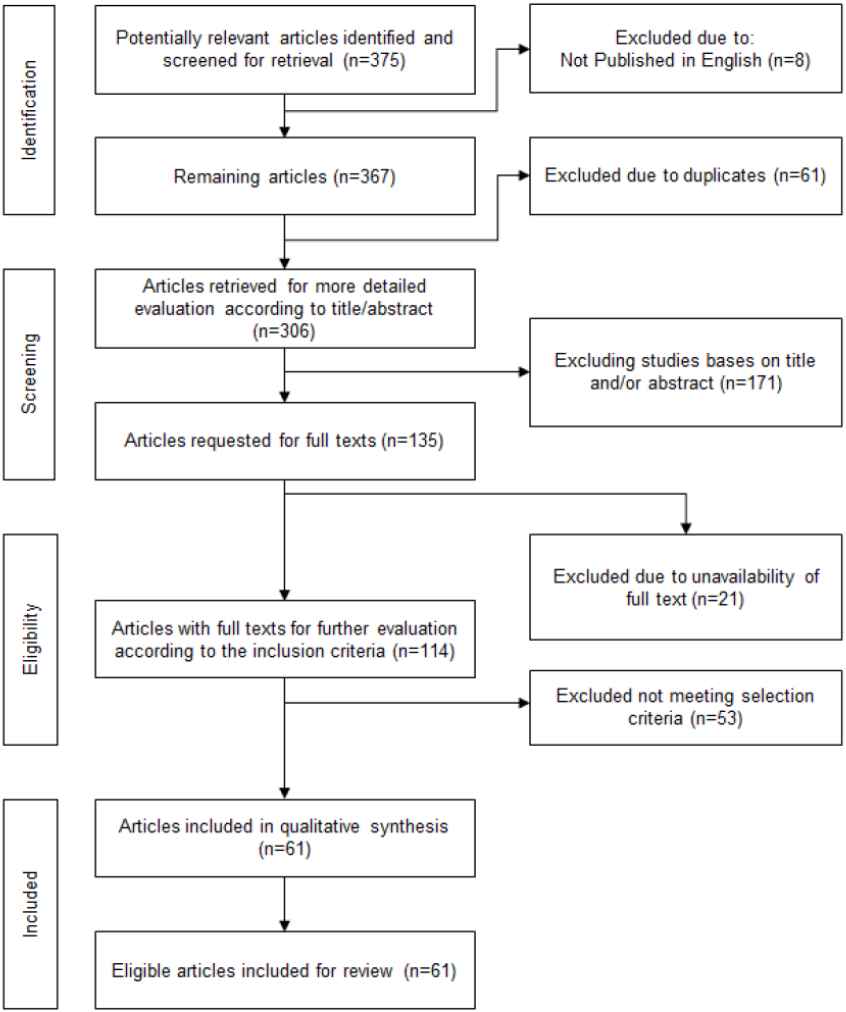
The selection process of marketing decision support systems for new product design.
2.3. Search and Selection Approach
Given the broad nature of the domain of research, we opted to start the search process with an automated search. We subsequently completed the set of papers through a reference search. We limited the search to electronic collections only and solely considered journals, conference proceedings, and workshop proceedings that were peer-reviewed.
The collection of 375 papers obtained by the automated search was reduced by applying the first filter on title and abstract, resulting in a set of 306 papers. Of these 306 papers, 61 were excluded for being considered duplicate publications of the same results. For duplicate papers, we keep the most complete and recent publication. After bringing together the papers returned by the automated search, we applied the selection criteria on the full papers. This yielded 114 papers to be included in the final paper set. At the end of the search process, we obtained 61 papers as a final set for the SLR.
2.4. Criteria for Study Selection
Selected articles show mainly DSS activity for supporting new product design, although some also include other features. The revised elements include DSS types, decision-making support, and distribution decision-making support.
Based on the questions presented above, to evaluate the retrieved data and analyze and interpret the literature, a selection of the publications was made based on the following elements of the papers: title, abstract, keywords, and conclusions. Starting from this selection, we divided them into categories using the following criteria:
DSS types: What are its operational characteristics, usage characteristics, user relationship characteristics, and technical characteristics?
- –
Operational classification: communication-driven, data-driven, document-driven, knowledge-driven, or model-driven [15]
- –
Analytical models classification: Sensitivity analysis, what if analysis, goal seeking, or optimization analysis [16]
- –
User-relationship classification: passive, active, or cooperative [17]
- –
Technical classification: desktop DSS or enterprise-wide DSS [15]
- –
Decision-making support (consumer satisfaction modeling): what is it based on?
- –
Knowledge-based systems
- –
Expert systems
- –
Hybrid system
- –
Multicriteria methods
- –
Other
- –
Distributed decision-making support: if it is implemented, what is it based on?
- –
Monolithic
- –
Layered
- –
SA
- –
Other
- –
3. RESULTS OF THE REVIEW
In this section, for each research question, we provide a summary of the data collected from the 61 papers [2,3,18–76].
Q1 What kinds of MDSSs have been developed to support product design?
The MDSS types as defined by the authors were collected and related as a result of this SLR. The MDSS types refer to MDSS aspects according to operational classification, analytical model classification, user-relationship classification, and technical classification. Table 2 presents the detailed final list of papers ordered by year of publication.
| No | Year | Authors | Product Development Activitya | Decision Support |
Distribution Supportd | Operational Classificatione | Analytical Models Classificationf | User-Relationship Classificationg | Technical Classificationh | |
|---|---|---|---|---|---|---|---|---|---|---|
| Based Onb | Modeling Consumer Satisfactionc | |||||||||
| 1 | 1998 | Nikos Matsatsinis et al. | D | CS | UTS | SA | MD | W-I | C | EWD |
| 2 | 1999 | N.F. Matsatsinis & Siskos | D | CS | UTS | NS | MD | W-I | C | DD |
| 3 | Ramesh & Tiwana | D | KBS | - | SA | KD | OA | P | EWD | |
| 4 | Subbu et al. | D | KBS | - | LY | KD | OA | P | EWD | |
| 5 | 2000 | W. Guo et al. | P/D/M | KBS | - | NS | KD | OA | P | DD |
| 6 | 2001 | Tiwana & Ramesh | C/D | KBS | - | LY | KD | OA | P | EWD |
| 7 | 2002 | Banerjee et al. | D/P | HS | - | SA | MD | OA | P | DD |
| 8 | Gargouri et al. | M | ES | - | NS | MD | OA | P | EWD | |
| 9 | Huang | D | - | - | LY | DD | OA | P | EWD | |
| 10 | Liang & Huang | D | CS | AI/EA | SA | MD | OA | P | EWD | |
| 11 | Zha | D | KBS | - | SA | KD | OA | P | EWD | |
| 12 | 2003 | Gargouri & Hammadi | M | ES | - | NS | MD | W-I | A | EWD |
| 13 | N. Matsatsinis et al. | D | CS | UTS | SA | MD | W-I | C | EWD | |
| 14 | Zha et al. | D | KBS | - | SA | KD | OA | P | EWD | |
| 15 | 2004 | Ai et al. | NS | KBS | - | SA | KD | OA | P | EWD |
| 16 | Frutos et al. | D | CS | AI/ILP | MN | MD | W-I | A | DD | |
| 17 | Zha et al. | D | KBS | - | LY | KD | W-I | A | DD | |
| 18 | 2005 | Alexouda | D | CS | AI/EA | NS | MD | W-I | DD | |
| 19 | An | D | - | - | NS | MD | W-I | A | DD | |
| 20 | Byun & Lee | PT | CS | TPS/CA | MN | MD | W-I | A | DD | |
| 21 | 2006 | Besharati et al. | D | CS | MOA/MC | MN | MD | W-I | C | DD |
| 22 | Xie | D | KBS | - | LY | KD | OA | A | DD | |
| 23 | G.Y.G. Yu & Yan | D | KBS | - | MN | MD | W-I | A | DD | |
| 24 | 2007 | Pandit & Zhu | D | - | - | MN | KD | OA | P | DD |
| 25 | Xu, Li, Li, & Tang | D | - | - | MN | MD | W-I | C | DD | |
| 26 | 2008 | Kamis, Koufaris, & Stern | D | - | - | NS | MD | W-I | A | EWD |
| 27 | Lu et al. | NS | ES | - | MN | MD | W-I | C | DD | |
| 28 | Wu et al. | D | KBS | - | NS | KD | W-I | A | DD | |
| 29 | 2009 | Barnes & Lillford | D | ES | - | MN | MD | OA | P | DD |
| 30 | Chang & Terpenny | D | HS | - | LY | MD | W-I | C | DD | |
| 31 | Xue et al. | D/M | ES | - | MN | MD | W-I | C | DD | |
| 32 | T.Y.T. Yu et al. | D | KBS | - | SA | KD | OA | P | DD | |
| 33 | 2010 | Balakrishnan et al. | D | CS | AI/HD | MN | MD | W-I | C | DD |
| 34 | Ching-Chin et al. | L | KBS | - | MN | MD | W-I | A | DD | |
| 35 | Morales & Ortega | DS | CS | AHP/FCM | SA | MD | OA | P | EWD | |
| 36 | Sancin, Dobravc, & Dolšak | D | ES | - | MN | KD | OA | A | DD | |
| 37 | 2011 | Chan & Ip | D | CS | FAHP/MC | MN | MD | OA | P | DD |
| 38 | F. Guo et al. | D | CS | AI/BPAN | LY | MD | W-I | A | EWD | |
| 39 | C. Liu et al. | D | KBS | - | NS | MD | W-I | C | DD | |
| 40 | Shin et al. | D | CS | AI/HOQ/INLP/HSA | MN | MD | W-I | A | DD | |
| 41 | Zarandi et al. | D | KBS | - | MN | KD | W-I | A | DD | |
| 42 | 2012 | Baril et al. | D | CS | AI/MOA/PP | MN | MD | W-I | A | EWD |
| 43 | Kaljun & Dolšak | D | KBS | - | MN | KD | W-I | A | DD | |
| 44 | Novak | D | KBS | - | MN | KD | OA | P | DD | |
| 45 | 2013 | Behzadian et al. | D | CS | PRMT | MN | MD | W-I | A | DD |
| 46 | Lindow et al. | D | KBS | - | MN | KD | OA | P | DD | |
| 47 | Song, Zhang, & Zhang | D | - | - | MN | MD | OA | P | EWD | |
| 48 | 2014 | Ghazilla, et al. | D | KBS/DP | - | MN | MD | W-I | C | DD |
| 49 | Li et al. | D | CS | RN | MN | MD | OA | P | EWD | |
| 50 | Lin et al. | D | CS | TOPSIS/NN | MN | MD | W-I | A | DD | |
| 51 | E. Liu et al. | D | CS | AHP/ANP/GP | MN | MD | OA | A | DD | |
| 52 | 2015 | Dostatni et al. | D | - | - | SA | MD | OA | A | DD |
| 53 | García-Diéguez, Herva, & Roca | D | KBS/DP | - | MN | KD | W-I | A | DD | |
| 54 | Guillard et al. | D | KBS | - | MN | MD | W-I | A | EWD | |
| 55 | Kłos | NS | KBS | - | MN | MD | W-I | A | DD | |
| 56 | Kulatunga et al. | P/D | - | - | MN | MD | W-I | A | DD | |
| 57 | Lei & Moon | D/P | KBS | - | MN | MD | W-I | C | DD | |
| 58 | Starostka-Patyk | D | - | - | LY | MD | W-I | A | DD | |
| 59 | 2016 | Yang, SS et al. | D | KBS | - | MN | MD | OA | P | DD |
| 60 | 2017 | Zhang, Chao et al. | D | KBS | - | MN | KD | OA | P | DD |
| 61 | 2018 | Yang, Dong et al. | D | KBS | - | MN | MD | W-I | A | DD |
Notes: (a) D = Design, P = Planning, M = Manufacturing, C = Concept, PT = Prototyping, L = Launch, NS = No Specified, DS = Decision Support. (b) CS = Consumer Satisfaction, KBS = Knowledge-Based System, HS = Hybrid System, ES = Expert System, DP = Designer Preferences. (c) TPS = TOPSIS, UTS = UTASTAR, AI = Artificial Intelligence, EA = Evolutionary Algorithms, ILP = Integer Linear Programming, CA = Conjoint Analysis, MC = Montecarlo, PRMT = PROMETHEE, HD = Heuristic Dynamic, FCM = Fuzzy C Means, AHP = Analytic Hierarchy Process, FAHP = Fuzzy Analytic Hierarchy Process, MC = Markov Chains, BPAN = BP Artificial Networks, INLP = Integer Non linear Programming, HSA = Heuristic Search Algorithms, MOA = Multi-Objective Algorithm, PP = Physical Programming, RN = Relation Network, NN = Neural Networks, GP = Goal Programming. (d) SA = Software Agents, LY = Layered, MN = Monolithic, NS = Not Specified. (e) DD = Document-Driven, KD = Knowledge-Driven, MD = Model-Driven, (f) W-I = What-If Analysis, OA = Optimization Analysis. (g) P = Passive, A = Active, C = Cooperative. (h) DD = Desktop DSS, EWD = Enterprise Wide DSS.
The detailed final list of papers ordered by year of publication.
| A1 | A2 | A3 | A4 | |
|---|---|---|---|---|
| Paper 1 | 1 | 0 | 0 | 1 |
| Paper 2 | 1 | 0 | 0 | 0 |
| Paper 3 | 0 | 1 | 1 | 1 |
| Paper 4 | 1 | 1 | 1 | 1 |
| Paper 5 | 1 | 0 | 0 | 0 |
| Paper 6 | 1 | 0 | 0 | 0 |
| Paper 7 | 0 | 1 | 0 | 1 |
| Paper 8 | 0 | 0 | 1 | 0 |
| Paper 9 | 0 | 0 | 0 | 1 |
| Paper 10 | 0 | 0 | 0 | 1 |
An example of 10 papers and four marketing decision support systems (MDSS) attributes.
To further analyze the distribution of papers across the various MDSS features, we use the method of Formal Concept Analysis [77]. This method allows to group the papers along with the different features that are addressed into a lattice and to visualize the commonality of particular MDSS attributes the level to which papers address the same or different MDSS attributes. Each node in the lattice identifies an MDSS attribute and the number of papers addressing precisely this MDSS attribute. In addition, upward lines denote a subset relationship. Table 3 shows an example of 10 papers along with four MDSS attributes. Figure 2 shows two resulting lattices. In lattice 2a each paper addresses the MDSS attributes of its node and all the MDSS attributes of the upward nodes. So, in this graph, we can see that papers 9 and 10 address only attribute A4. Papers 1, 3, 4, and 7 also address attribute A4 but simultaneously address other MDSS attributes as well. The lattice can also be visualized with (cumulative) object counts rather than paper labels, as in Figure 2b. This allows to easily seeing how often an attribute is addressed: the higher the node of an attribute, the more often it is addressed. The lattice also visualizes which attributes are often addressed together. Nodes with explicitly attached MDSS attributes have a full-color fill, while half-filled nodes accumulate papers that (solely) combine the MDSS attributes attached to higher nodes. The size of the nodes is proportional to the number of papers attached to the node.
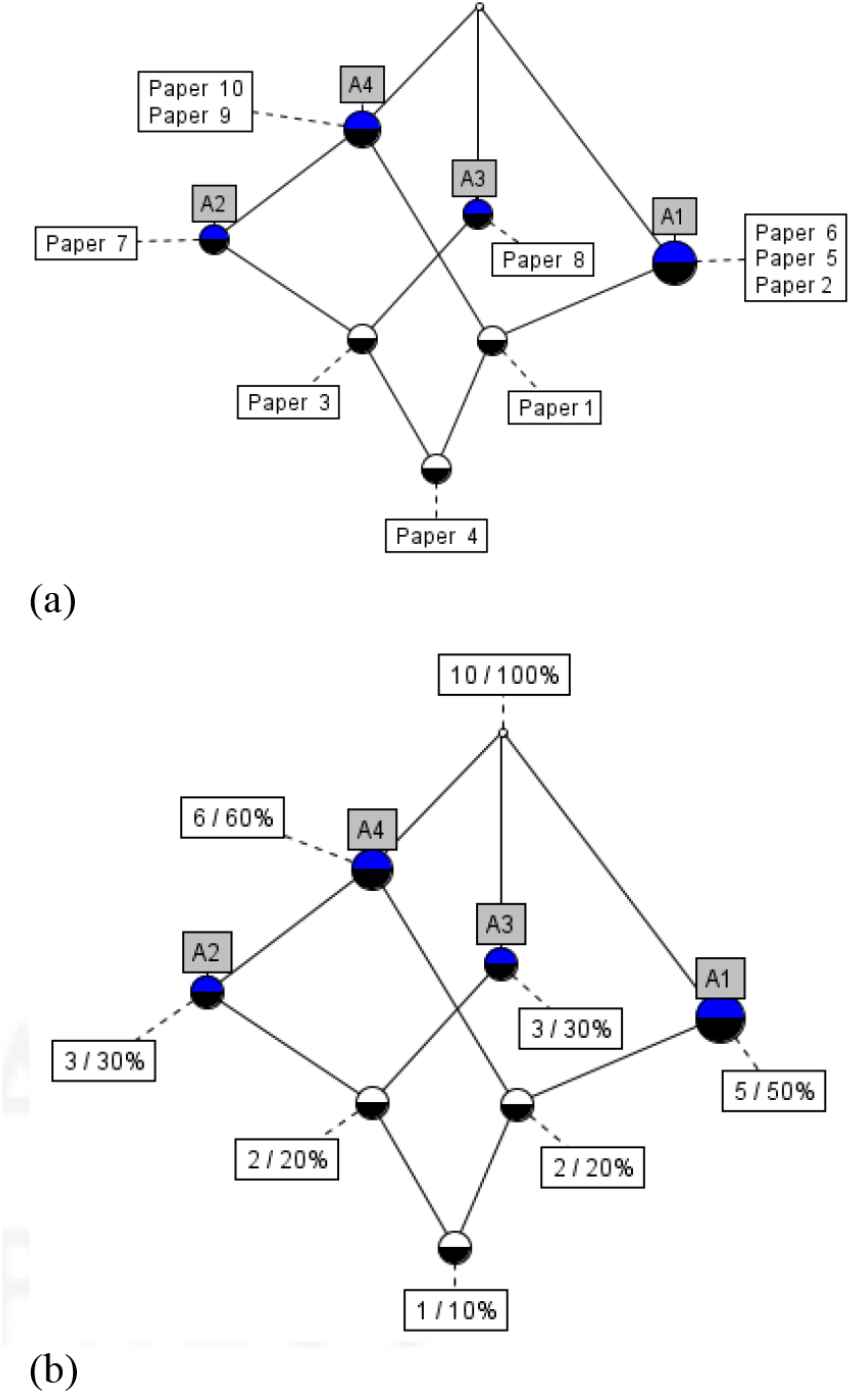
Resulting lattices for the example shown in Table 3.
Considering the general category of operational classification of the revised MDSS, we can see that of the 61 selected papers, 41 are model-driven and use data and rules input from the system-users themselves, while 19 are knowledge-driven and store rules and procedures. Only one is document-driven and its purpose is to search web pages and find documents on a specific set of keywords or search terms. Communication-driven and data-driven MDSS were not found in revised MDSS. Figure 3 shows the distribution of papers among model-driven, knowledge-driven, and document-driven clusters.
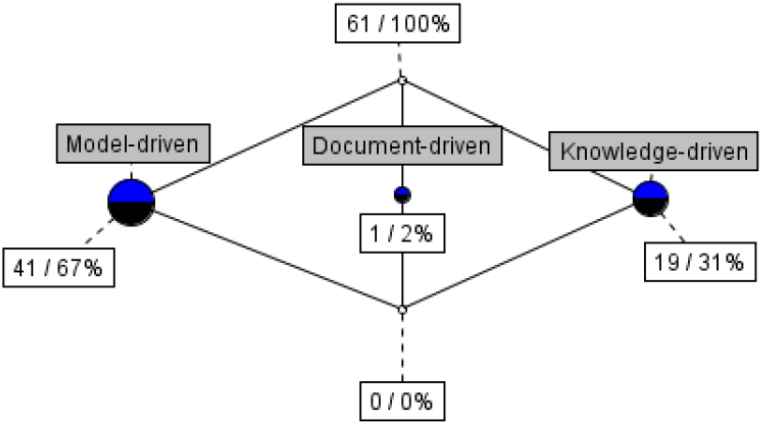
Distribution of papers among model-driven, knowledge-driven, and document-driven clusters.
With respect to the category of analytical model classification, we can see that of the 61 selected papers, 35 use what-if analysis allowing the user to see how a change in value for one variable affects other variables, while 26 use optimization analysis for identifying the optimal values of given variables under defined constraints. Goal seeking and sensitivity analysis were not found in the revised MDSSs. Figure 4 shows the distribution of papers among what-if and optimization clusters.
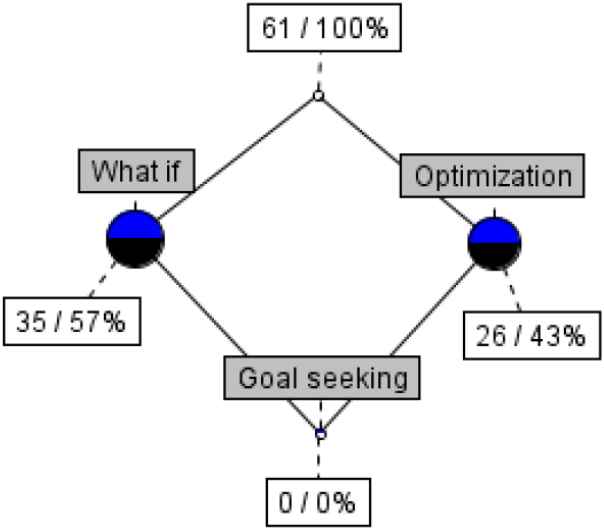
Distribution of papers among what-if and optimization clusters.
In the category of user-relationship classification, we found that of the 61 selected papers, 27 are active and can make explicit recommendations to the users, while 22 are passive and help decision-making without making explicit recommendations, and 12 are cooperative and let the user modify such recommendations. Figure 5 shows the distribution of papers among active, passive, and cooperative clusters.
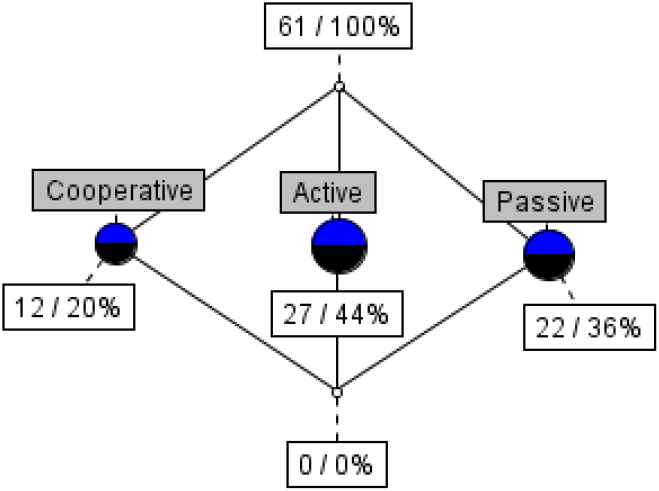
Distribution of papers among active, passive, and cooperative clusters.
In the technical classification, we found that 42 are desktop MDSSs, where only one user can access the system at a time, while 19 papers were enterprise-wide, where many users have access. Figure 6 shows the distribution of papers among desktop and enterprise clusters.
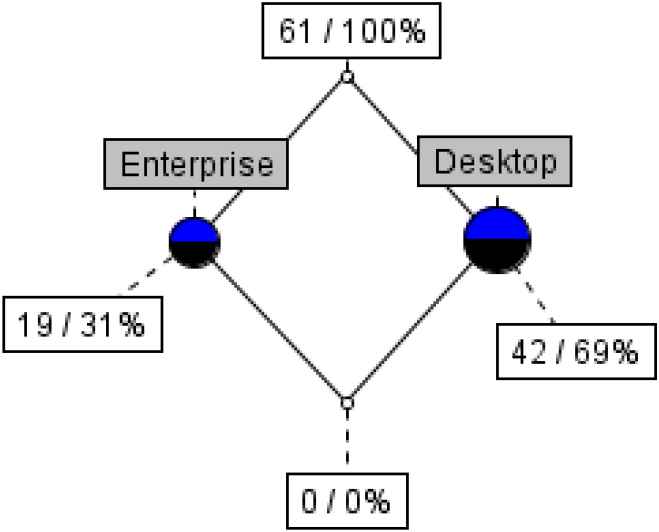
Distribution of papers among desktop and enterprise clusters.
Q2 With reference to consumer satisfaction modeling, how is the decision-making support implemented?
The purpose of investigating how decision-making support is implemented in the revised MDSS is to determine what consumer satisfaction modeling uses. We can see that of the 61 selected papers its implementation is diverse, 14 papers are carried out through consumer satisfaction models based on artificial intelligence techniques, while 9 papers use multicriteria methods. We found 42 MDSSs in the literature which are not based on consumer satisfaction models, they include, knowledge-based systems, expert systems, and hybrid systems. This is an indication that the field of consumer satisfaction modeling still needs to gain in maturity. Figure 7 shows the distribution of papers among MDSS based or not on consumer satisfaction models.
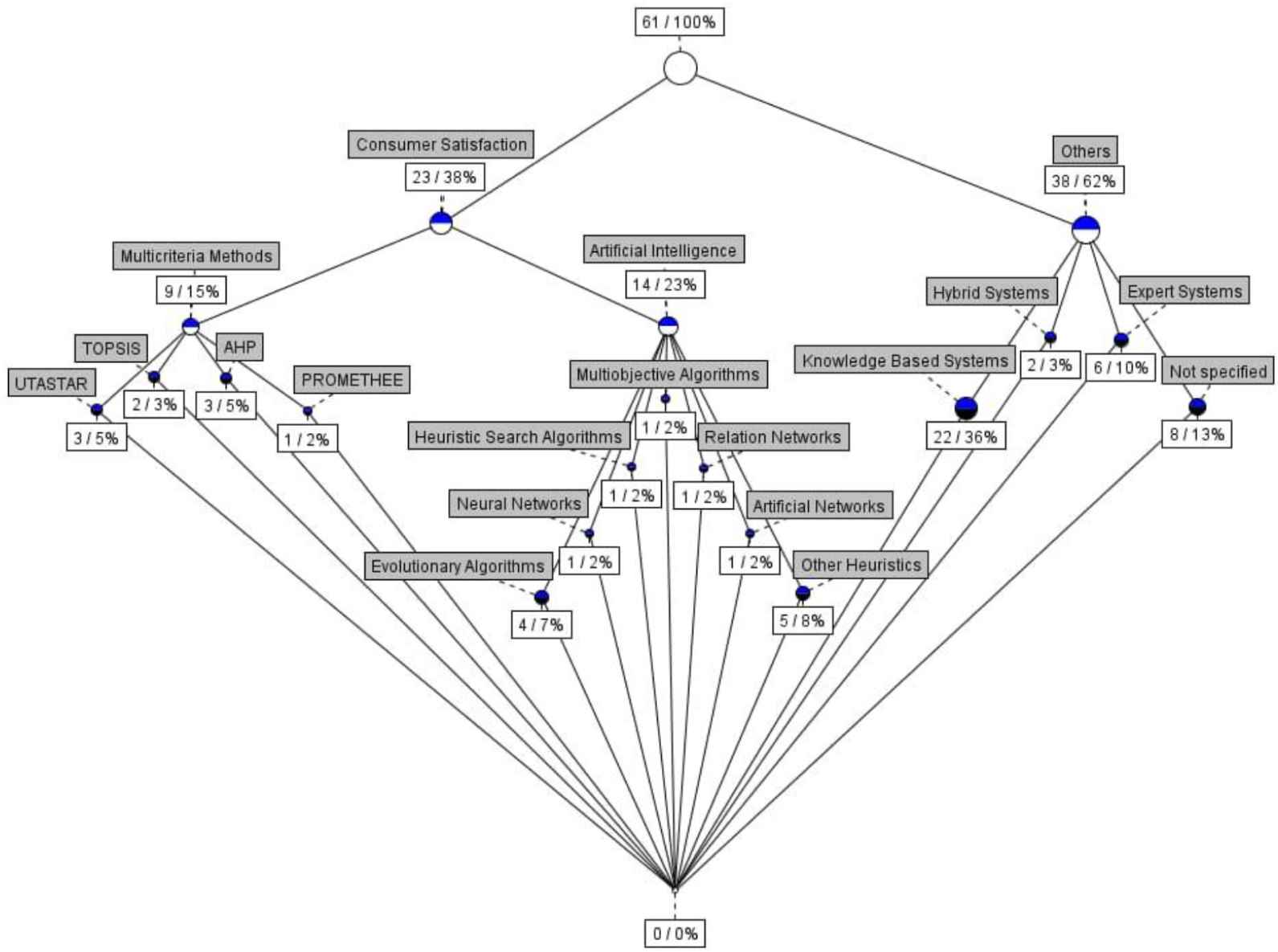
Distribution of papers among marketing decision support system (MDSS) based or not on consumer satisfaction models.
Q3 How is the distributed decision-making support implemented?
Regarding distributed decision-making support, the lattice diagram in Figure 8 shows the results. In this, we can see that from the 61 revised MDSSs, support for operational processes in distributed environments was considered in 22 papers (36%) (Y) and it was not in 39 papers (64%) (N).
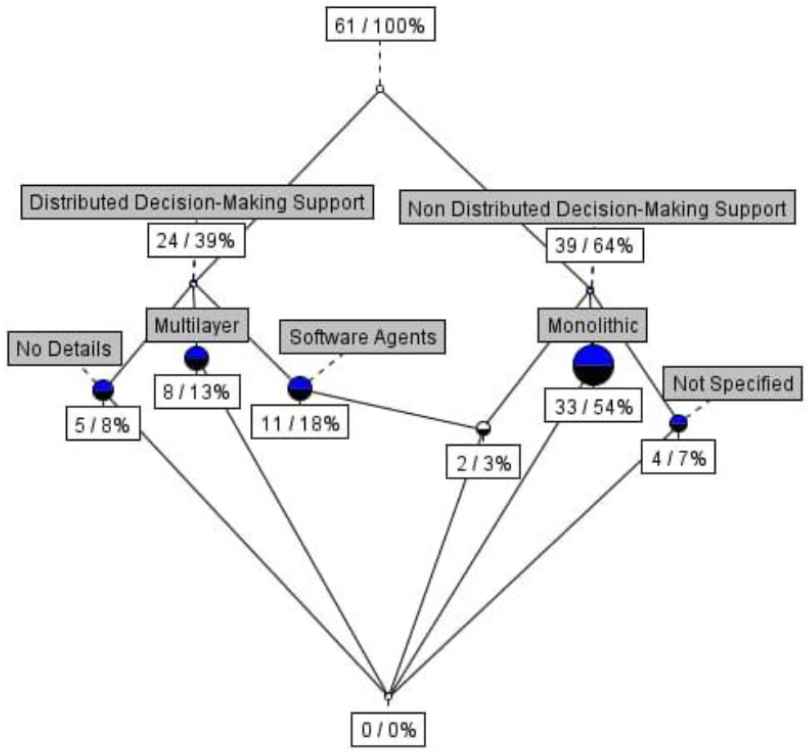
Lattice diagram of marketing decision support system (MDSSs) distributed decision-making support.
For the 22 papers that support it, distributed decision-making was implemented mainly through SAs (9) and multilayer (LY) architectures (8). For 5 papers, there were no details of how it was implemented (not specified [NS]). Of the 39 papers that do not support it, monolithic architecture (MN) was found in 33 papers and it was NS in 4 papers.
Regarding consumer satisfaction modeling, we found that consumer satisfaction was modeled in 23 (37%) of the 61 reviewed MDSSs. Among these, 9 were modeled using multi-criteria decision analysis methods and 14 using different artificial intelligence techniques.
One example is the model presented by [19], which is based on the principles of multicriteria analysis and belongs to the broader category of preference disaggregation models. This model of customer satisfaction measurement attempts to examine and analyze the multicriteria behavior of a set of customers given that multicriteria preferences of them are known. Its main objective is to aggregate the opinions of the customers into a function by assuming that the global satisfaction of the customer depends on a set of criteria or variables that are expressed by the features of a product or service. According to the model, each customer expresses their judgment about the product or the service and their satisfaction concerning each criterion. The model estimates global and partial satisfaction functions based on the evaluations of the customers. The application of this model allows for the calculation of the weights of the criteria and in the calculation of the mean indices of global and partial satisfaction.
With respect to distributed environment implementation, we found that a distributed environment was implemented in 22 (36%) of the 61 revised MDSSs. It was found that various technologies were used to support the distribution of participants in the decision process. Open DataBase Connectivity (ODBC) was used for databases; Hypertext Transfer Protocol (HTTP) and Secure Sockets Layer (SSL) were used for the Internet; Common Object Request Broker Architecture (CORBA), DCOM, and Remote Method Invocation (RMI) were used for distributed objects; and Java Agent Development Framework (JADE) was used for agents. The middleware mainly used to support distribution were HTTP for web sites and JADE for agent-based architectures.
Concerning consumer satisfaction modeling and distributed environment implementation, only 4(6%) of the 61 revised MDSSs considered consumer satisfaction and a distributed work environment together. Figure 9 shows the resulting analysis lattice and Appendix A presents a summary of paper attributes according to their decision and distribution support.
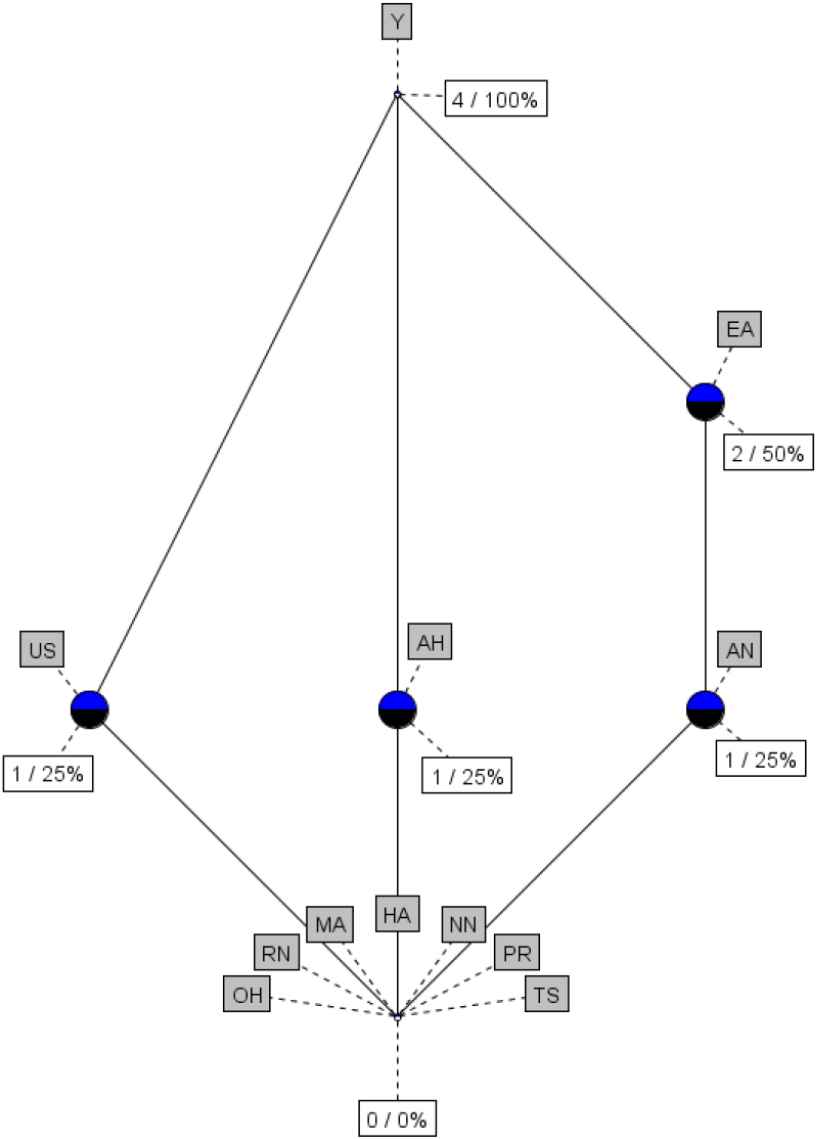
Lattice diagram of marketing decision support systems (MDSSs) with both distributed environment and consumer satisfaction support.
4. DISCUSSION OF THE RESULTS AND FUTURE WORK
The research presented here is a SLR of papers that consider MDSSs for new product design based on the SLR guidelines proposed by [5]. We analyzed 375 articles published between 1998 and 2018, of which 61 were selected because they were the ones directly related to the subject of interest. We classified papers according to MDSS types and on what decision-making and distributed decision-making was based on.
As far as the operational classification efforts are concerned, some interesting results indicate that model-driven and knowledge-driven are the operational classifications most used in the reviewed papers (67% and 31%, respectively). Only one system was classified as document-driven and, we did not find any study that investigates the operational procedure of the MDSS from a communication-driven or data-driven perspective. This is because most of the systems have advanced functions to build and issue new product design recommendations and use advanced techniques of information manipulation to do so. They store rules and procedures or handle input data from the users and rules, and they are the most suitable for this type of system. We think that this trend will continue in future developments because these operational characteristics are the most consistent with the current nature of this decision-making process.
Results of analytical model classification show that all MDSSs use what-if or optimization analysis. In this way, the exploration of this type of analytical model can be an opportunity for future work. Another interesting result in this category was in the user-relationship classification. Most of the revised MDSSs are active or passive, and only 19% of them are cooperative, that is, they allow the user to modify their recommendations and adapt them to their needs. We think that this can be an important characteristic in this type of MDSS; in this way, the users could refine the recommendations issued by the system to adjust them to their particular needs. Considering this feature in future developments will help to build more interactive systems that allow more user participation in design recommendations. According to its technical classification, 69% of revised systems are desktop MDSSs. However, we believe that this is due to the technological limitations of concurrency inherent to the systems developed in past years and that this trend will gradually change as systems with newer technologies are developed.
On the side of decision-making support, the landscape of MDSS for new product design is quite scattered. It was found that 37% of the papers consider and model consumer satisfaction to issue their recommendations and the remainder are based on other techniques such as knowledge-based systems, hybrid systems, or expert systems. A finding that is worth emphasizing is that only 14% of these use multicriteria methods to model. Multicriteria decision-making (MCDM) has been an active area of research since the 1970s and different methods for solving MCDM problems have been published; these include AHP, PROMETHEE, TOPSIS, ELECTRE, ANP, UTASTAR, SMART, and MAUT (Ehrgott et al., 2016). In this sense, many papers report the satisfactory application of them in various disciplines such as sustainable and renewable energy, transportation systems, service quality, energy management e-learning, tourism, and hospitality. However, in the reviewed papers, its use and application are scarce: only three MDSSs for new product design use UTASTAR, two use TOPSIS, three use AHP, and one uses PROMETHEE. The use of any other method is not reported. This insight points to the value of further research in the use of multicriteria methods in this type of system.
The review of distributed decision-making support shows us that only 36% of the papers consider it. Of these, 13% use a layer-based architecture and 18% uses a SAs-based one. This may be due to the technological limitations of systems developed in the past years. Nevertheless, future developments should be more consistent with the characteristics of new product designs of the current decision process, whose solution is carried out by receiving information from different sources then decomposing it into different tasks and gradually solving these tasks and integrating each task's result to get the complete solution. In this way, we believe that the exploration of new distributed programming technologies to support this decision problem more effectively can be an opportunity for future work in the coming years.
An additional finding that is important to highlight is that only 6% of the papers presented consider both consumer satisfaction and distributed work environment together; these are very important elements in the current process of developing new products and most of the systems reviewed do not take these elements into account. This represents another area of opportunity, and it would be interesting to take them into account in future developments.
5. CONCLUSIONS
This paper presents an SLR on MDSSs for new product design. Its objective was to assess the state of art in this research area. It was found that in most of these systems are model-driven, using what-if analysis, have active user-relationships, and are desktop MDSSs. Implementation of decision-making support principally includes knowledge-based systems and expert systems. Consumer satisfaction is used to a lesser extent and it is modeled using mainly artificial intelligence methods. Distributed decision-making environments are moderately considered through layer-based or SA architectures and most systems are monolithic. Only 6% of the revised MDSSs considered consumer satisfaction and a distributed work environment together. These are both new and important challenges in the modern new product development process.
The above mentioned aspects provide indications that the field of MDSS for new product design still needs to gain in maturity. Based on our interpretation of the SLR results, we suggest further research should explore different elements such as cooperative user-relationships, being enterprise-wide, using more multicriteria methods to model consumer satisfaction, and providing greater support to distributed decision-making using different technologies. We believe that in this way, future developments will be more consistent with the current nature of this decision problem and they will be able to provide more effective support. From our study, it has become clear that there are plenty of open research questions around MDSS for new product design that seems worthwhile to pursue, both from an academic and practical perspective.
ACKNOWLEDGMENTS
This work is part of the “Development of a decision support system based on intelligent agents for the design of new agro-industry products” research project #2015-01-162, financed by the Mexican National Council for Science and Technology (Conacyt). This work is partially supported by the Spanish National research project TIN2015-66524-P and ERDF.
APPENDIX A Summary of paper Attributes according to their decision and distribution support
| Attributes |
|||||||||||||||||||||||
|---|---|---|---|---|---|---|---|---|---|---|---|---|---|---|---|---|---|---|---|---|---|---|---|
| Decision Support |
Distribution Support |
||||||||||||||||||||||
| Consumer Satisfaction |
Other |
Implemented? |
Environment Architecture |
||||||||||||||||||||
| Multicriteria Method |
Artificial Intelligence |
||||||||||||||||||||||
| Papers | Year | MDSS | UTASTAR | TOPSIS | AHP | PROMETHEE | Evolutionary Algorithm | Neural Network | Heuristic Algorithm | Multi-objective Algorithm | Relation Network | Artificial Network | Other | Knowledge-Based System | Hybrid System | Expert System | Unspecified | Yes | No | Monolithic | Layered | Software Agents | Unspecified |
| 1 | 1998 | Nikos Matsatsinis et al. | 1 | 1 | 1 | ||||||||||||||||||
| 2 | 1999 | N.F. Matsatsinis & Siskos | 1 | 1 | 1 | ||||||||||||||||||
| 3 | Ramesh & Tiwana | 1 | 1 | 1 | |||||||||||||||||||
| 4 | Subbu et al. | 1 | 1 | 1 | |||||||||||||||||||
| 5 | 2000 | W. Guo et al. | 1 | 1 | 1 | ||||||||||||||||||
| 6 | 2001 | Tiwana & Ramesh | 1 | 1 | 1 | ||||||||||||||||||
| 7 | 2002 | Banerjee et al. | 1 | 1 | 1 | ||||||||||||||||||
| 8 | Gargouri et al. | 1 | 1 | 1 | |||||||||||||||||||
| 9 | Huang | 1 | 1 | 1 | |||||||||||||||||||
| 10 | Liang & Huang | 1 | 1 | 1 | |||||||||||||||||||
| 11 | Zha | 1 | 1 | 1 | |||||||||||||||||||
| 12 | 2003 | Gargouri & Hammadi | 1 | 1 | 1 | ||||||||||||||||||
| 13 | N. Matsatsinis et al. | 1 | 1 | 1 | |||||||||||||||||||
| 14 | Zha et al. | 1 | 1 | 1 | |||||||||||||||||||
| 15 | 2004 | Ai et al. | 1 | 1 | 1 | ||||||||||||||||||
| 16 | Frutos et al. | 1 | 1 | 1 | |||||||||||||||||||
| 17 | Zha et al. | 1 | 1 | 1 | |||||||||||||||||||
| 18 | 2005 | Alexouda | 1 | 1 | 1 | ||||||||||||||||||
| 19 | An | 1 | 1 | 1 | |||||||||||||||||||
| 20 | Byun & Lee | 1 | 1 | 1 | |||||||||||||||||||
| 21 | 2006 | Besharati et al. | 1 | 1 | 1 | ||||||||||||||||||
| 22 | Xie | 1 | 1 | 1 | |||||||||||||||||||
| 23 | G.Y.G. Yu & Yan | 1 | 1 | 1 | |||||||||||||||||||
| 24 | 2007 | Pandit & Zhu | 1 | 1 | 1 | ||||||||||||||||||
| 25 | Xu, Li, Li, & Tang | 1 | 1 | 1 | |||||||||||||||||||
| 26 | 2008 | Kamis, Koufaris, & Stern | 1 | 1 | 1 | ||||||||||||||||||
| 27 | Lu et al. | 1 | 1 | 1 | |||||||||||||||||||
| 28 | Wu et al. | 1 | 1 | 1 | |||||||||||||||||||
| 29 | 2009 | Barnes & Lillford | 1 | 1 | 1 | ||||||||||||||||||
| 30 | Chang & Terpenny | 1 | 1 | 1 | |||||||||||||||||||
| 31 | Xue et al. | 1 | 1 | 1 | |||||||||||||||||||
| 32 | T.Y.T. Yu et al. | 1 | 1 | 1 | |||||||||||||||||||
| 33 | 2010 | Balakrishnan et al. | 1 | 1 | 1 | 1 | |||||||||||||||||
| 34 | Ching-Chin et al. | 1 | 1 | 1 | |||||||||||||||||||
| 35 | Morales & Ortega | 1 | 1 | 1 | |||||||||||||||||||
| 36 | Sancin, Dobravc, & Dolšak | 1 | 1 | 1 | |||||||||||||||||||
| 37 | 2011 | Chan & Ip | 1 | 1 | 1 | ||||||||||||||||||
| 38 | F. Guo et al. | 1 | 1 | 1 | 1 | ||||||||||||||||||
| 39 | C. Liu et al. | 1 | 1 | 1 | |||||||||||||||||||
| 40 | Shin et al. | 1 | 1 | 1 | 1 | ||||||||||||||||||
| 41 | Zarandi et al. | 1 | 1 | 1 | |||||||||||||||||||
| 42 | 2012 | Baril et al. | 1 | 1 | 1 | ||||||||||||||||||
| 43 | Kaljun & Dolšak | 1 | 1 | 1 | |||||||||||||||||||
| 44 | Novak | 1 | 1 | 1 | |||||||||||||||||||
| 45 | 2013 | Behzadian et al. | 1 | 1 | 1 | ||||||||||||||||||
| 46 | Lindow et al. | 1 | 1 | 1 | |||||||||||||||||||
| 47 | Song, Zhang, & Zhang | 1 | 1 | 1 | |||||||||||||||||||
| 48 | 2014 | Ghazilla, et al. | 1 | 1 | 1 | ||||||||||||||||||
| 49 | Li et al. | 1 | 1 | 1 | |||||||||||||||||||
| 50 | Lin et al. | 1 | 1 | 1 | 1 | ||||||||||||||||||
| 51 | E. Liu et al. | 1 | 1 | 1 | 1 | ||||||||||||||||||
| 52 | 2015 | Dostatni et al. | 1 | 1 | |||||||||||||||||||
| 53 | García-Diéguez, Herva, & Roca | 1 | 1 | 1 | |||||||||||||||||||
| 54 | Guillard et al. | 1 | 1 | 1 | |||||||||||||||||||
| 55 | Kłos | 1 | 1 | 1 | |||||||||||||||||||
| 56 | Kulatunga et al. | 1 | 1 | 1 | |||||||||||||||||||
| 57 | Lei & Moon | 1 | 1 | 1 | |||||||||||||||||||
| 58 | Starostka-Patyk | 1 | 1 | 1 | |||||||||||||||||||
| 59 | 2016 | Yang, SS et al. | 1 | 1 | 1 | ||||||||||||||||||
| 60 | 2017 | Zhang, Chao, et al. | 1 | 1 | 1 | ||||||||||||||||||
| 61 | 2018 | Yang, Dong, et al. | 1 | 1 | 1 | ||||||||||||||||||
| Total | 3 | 2 | 3 | 1 | 4 | 1 | 1 | 1 | 1 | 1 | 5 | 26 | 2 | 6 | 8 | 22 | 39 | 33 | 8 | 11 | 9 | ||
REFERENCES
Cite this article
TY - JOUR AU - J. Francisco Figueroa-Perez AU - Juan C. Leyva-Lopez AU - Luis C. Santillan AU - Edgar O. Pérez Contreras AU - Pedro J. Sánchez PY - 2019 DA - 2019/06/10 TI - The Use of Marketing Decision Support Systems for New Product Design: A Review JO - International Journal of Computational Intelligence Systems SP - 761 EP - 774 VL - 12 IS - 2 SN - 1875-6883 UR - https://doi.org/10.2991/ijcis.d.190624.001 DO - 10.2991/ijcis.d.190624.001 ID - Figueroa-Perez2019 ER -
